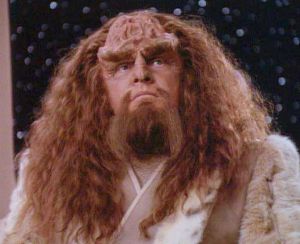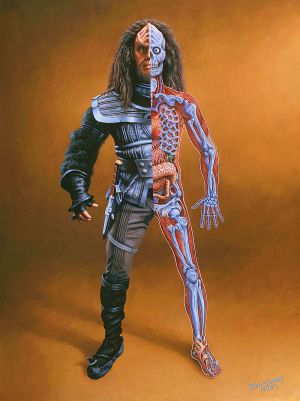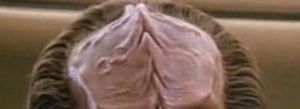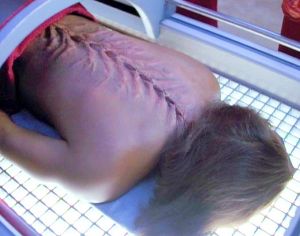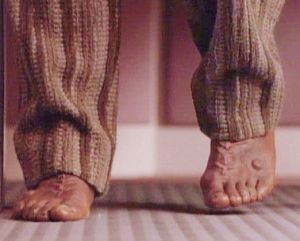Klingon Anatomy
Like other humanoids, the Klingon anatomical form consists of a head, neck, torso, and four limbs.
Internally, there are multiple redundancies for the organs, a principle the Klingons call “brak'lul."
These redundancies allowed Klingons to survive severe injuries, especially when engaged in battle.
Contents
Redundancies
Examples of organ redundancies:
- Twenty-three pairs ribs
(Humans have 12 pairs) - Three lungs
(Most humanoids have two) - Eight-chambered heart
(Human hearts are four-chambered) - Two livers
(Most humanoids have one) - Two stomachs
(Most humanoids have one) - Two urinary tracts
(Most humanoids have one) - Redundant neural function
Unfortunately, Klingons historically have relatively little knowledge of their own biology, and as a result, their medicine was very poorly developed.
This was largely due to their warrior traditions: a Klingon who was wounded was expected to be left to either survive through his own strength, die, or undergo the “hegh'bat,” a form of ritual suicide.
Instead, their species’ history of in-fighting was what educated them on what was lethal for them.
Surface Anatomy
The most distinctive feature of the modern Klingon is what is commonly known as their “head ridges,” located on the sagittal crest. Ridges begin on the forehead, and often continue onto the rest of the skull. Ridges differed between individuals, with slight variations among the same genetic line. The cranium itself is encased in an exoskeleton, possessing a feature known as the “tricipital lobe.”
The lower half of the face tends to follow a “familiar” humanoid appearance, and the ridges on the back of the head (if there are any) tend to be less pronounced. This leaves the general shape similar to the Human skull, though the Klingon skull will be covered in more skin than bone. These regions are where hair growth is likely to start.
Eyebrows tend to grow in a more diagonal direction than other humanoids, but also are known to have noticeably diagonal suborbital ridges where eyebrows otherwise exist.
Eyes are generally round in size and shape. They may flash more white of their eyes, a technique which is used to intimidate a rival or enemy. Klingons, especially females, were said to lack tear ducts, though this is only a myth, as Klingons see crying as a sign of weakness (and therefore not honorable).
Cheeks are more physically pronounced, with a vertical ridge that goes down the chin, into the neck. This expands into ridges on the upper chest and shoulders, and between the breasts of females. The neck structure varied from smooth flesh to flesh containing bony structures, which lead up the side of the head, and down the back of the head and spine.
Noses tend to vary: they can have between several slight horizontal ridges on the brow of their noses, to a single vertical ridge or crack. These formations start from the top of the brow down to the tip of the nose, and are known to be wider and flatter, as well as nearly flush against the forehead. There can also be heavier ridges over the nostrils, compared to the two minimally ridged or un-ridged nostrils. The nose of a Klingon tends to lay flatter on the face than in other Humanoids, as well and wider.
Teeth typically consist of two sharp fangs (incisors), with crooked or sharpened teeth. Mythos states that Klingons sharpen their teeth, often before going into battle.
Klingons of both sexes usually have hair on their heads. Male Klingons often have facial hair as well, possibly as a sign of masculinity or honor. Hair was usually long, described as thick and luxuriant. Again, the length of the hair is seen as a sign of honor: the cutting of a Klingon’s beard or other hair is often seen as a sign that the Klingon in question has done something dishonorable. Accelerated hair growth was often experienced by Klingons during puberty (“jak'tahla”). Klingon puberty also is marked with severe mood swings and unusual aggressive tendencies. Klingon hair greyed with age, eventually becoming white if the Klingon lives long enough.
- White hair is controversial: to die of old age is often seen as a dishonorable death, though the Klingon in question is also seen as very wise. It is not uncommon for an aged Klingon to perform ritual suicide.
Chests of Klingon males are largely smooth and slick, while the females have a large chest area, with ridges that come down to the top of their breasts across their shoulders. The backs of these Klingons are typically highly-covered with ridges, from shoulder to shoulder, and across the small of the back radiating from highly defined and thickly ridged spines. The sides of the abdomen of at least the females appears to be highly-defined, with rib-like ridges as well. The buttocks region can also be heavily ridged.
Klingons can also have ridged spines, chests and feet. After birth, some Klingon infants experienced a pronounced curvature to the spine, a form of scoliosis, which is correctable by surgery. This defect is genetic, and tends to be the dominant gene among the females that possess the genetics for it. Federation medicine allows for an additional choice of treatment involving genetic modification of the fetus.
Physiology
Skin colors range from olive, brown, and black.
Klingon nutritional requirements were typical of most humanoids, whereas, Dr. Pulaski once noted that, while their food was considered by most to be unpalatable, usually, “what kills us, kills them.”
Children mature far more quickly than other humanoid children. For example: at the age of only one Earth year, a Klingon child has the appearance a Human child would at age four. By the age of eight Earth years, a Klingon attains the maturity a Human child would not reach until about age sixteen. When Klingon children begin growing into adults, they go through “jak'tahla,” a Klingon version of puberty. Like other mammalian species, Klingon females were capable of lactating to breast-feed infants, a trait that starts developing during jak'tahla.
Blood varied in color from dark red (circulating) to more of a lightish pink (when openly bleeding). Klingon blood could contain ribosomes that were compatible for transfusion with a Romulan.
While Klingons are known to be larger and physically stronger than most species, they possess a much lower tolerance to the cold.
The odor Klingons produce is strong to both Humans and Vulcans. It has been described as a “stench,” as well as an “earthy, peaty aroma.”
Elders
The lifespan of a Klingon can last for over 150 years. Even into advanced old age, Klingons were usually still strong enough for combat, but were still susceptible to various mental conditions associated with old age.
A Klingon who dies of old age can be seen as dying a dishonorable death. It is not uncommon for an aged Klingon to perform ritual suicide, known as “Hegh'bat.”
Augment Virus
Created by a mutation of the Levodian flu, the “augment virus” was inadvertently created by Klingon researchers. They were attempting to bio-engineer enhanced warriors, using the DNA from genetically-modified Human embryos left over from Earth's Eugenics Wars. Klingons affected from this virus lost their cranial ridge features, and were in essence, remarkably similar in appearance to modern Humans.
Though the cure for this virus had been distributed throughout the Empire, the afflicted Klingons' DNA had been altered by the virus. This meant that the genetics for this condition was passed onto the descendants of the infected. Initially, there were millions of Klingons who had to live with the disfigurement for well over a century.
- Human in appearance, and distinguishable primarily by tricorder readings alone, the creatures known as tribbles were still able to single out and identify these Klingons.
Pregnancy
Klingon pregnancies are normally thirty weeks.
As early as seven weeks, a fetus with even a single Klingon grandparent is able to kick the uterine wall hard enough to be felt externally.
Hybridization
Hybridization revealed that Klingon DNA tended to be more dominantly expressive in the physical appearance of their offspring.
When mixed with other species’ genetics, gestation times have been known to be shorter. When bred with other species, the child typically showed characteristics of both species. The odds against Klingon-Human conceptions were rather high. However, when successful, Klingon and Human metabolisms sometimes clashed, causing biochemical fluctuations in the mother, which may lead to fainting.
Klingon traits remained dominant for several generations, even with a single ancestor. For example, a child even ¼ Klingon would still possess forehead ridges.
In the case of Romulan-Klingon hybridization, the Romulan ears were the only visible telltale indication of their non-Klingon heritage.
Evolutionary Origins
Like their Human, Cardassian, Vulcan, and Romulan counterparts, Klingons and many of the Milky Way's species all shared a common ancestry back to the ancient humanoids and the DNA code they produced and seeded across the galaxy.
Though each evolved under separate conditions from each other, their shared DNA allowed these species to remain roughly compatible and viable with each other.
Possessing extreme strength and speed, early Klingons were quite large, weighing up to 200 kilograms, or roughly 440 pounds. They were armored with an exoskeleton, with spines and bony plates protruding from their sides, upper arms, and back, arms ended with clawed pincers. Their faces possessed venom sacs, filled with a bio-acidic compound, as well as spitting glands inside their mouths, which were used for defense and to mark territory. Early Klingons also had two mandibles protruded from their lower jaw.
Prehistoric males used vocalizations to frighten other predators, mark territory, and commence the mating process. Early Klingon mating rituals involved biting the intended mate, in order to induce pheromone production in the sebaceous glands. Once the mate was ready, the pheromones drew the male Klingon back to its location.
